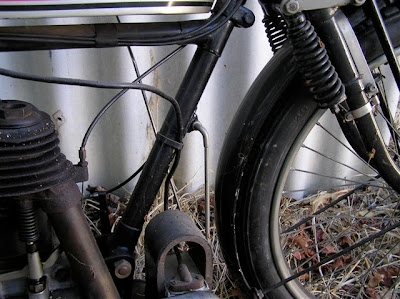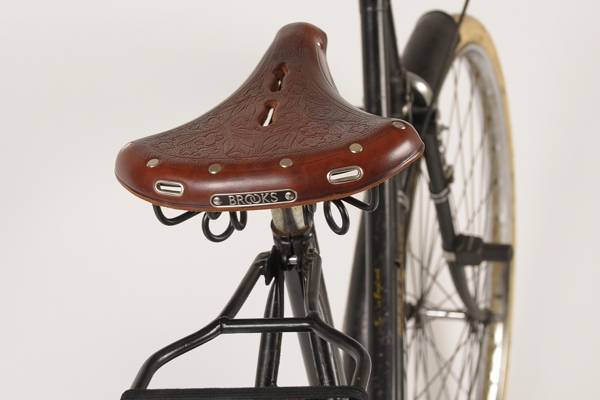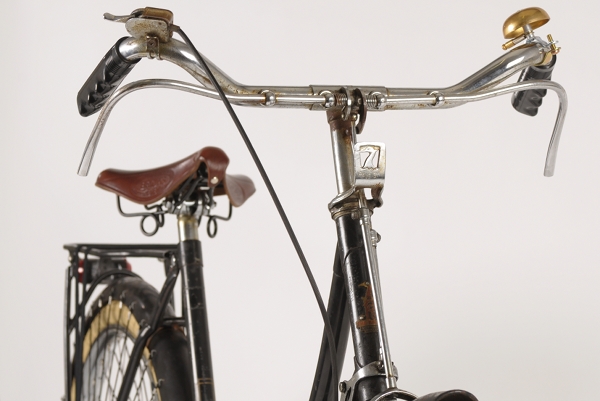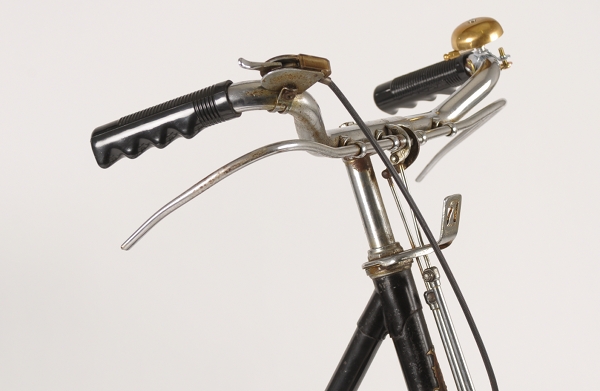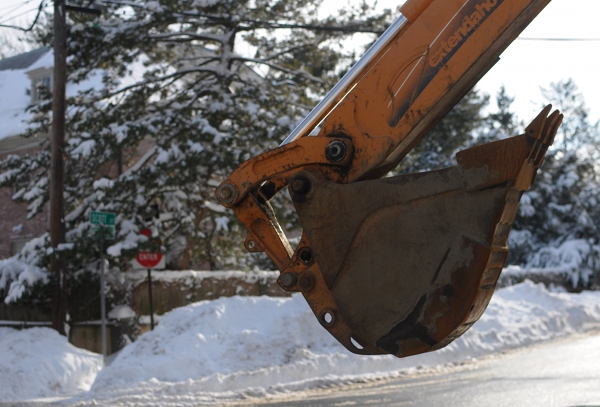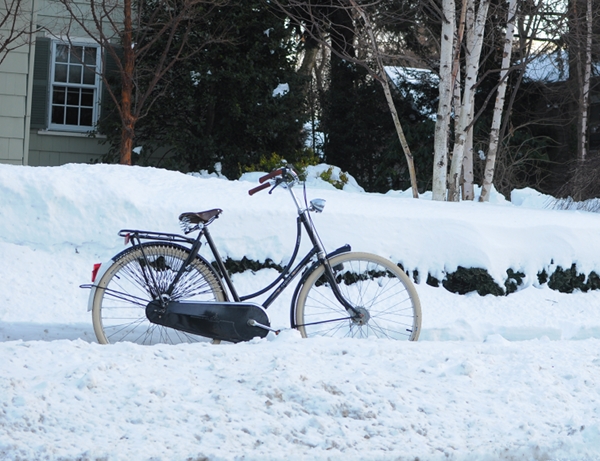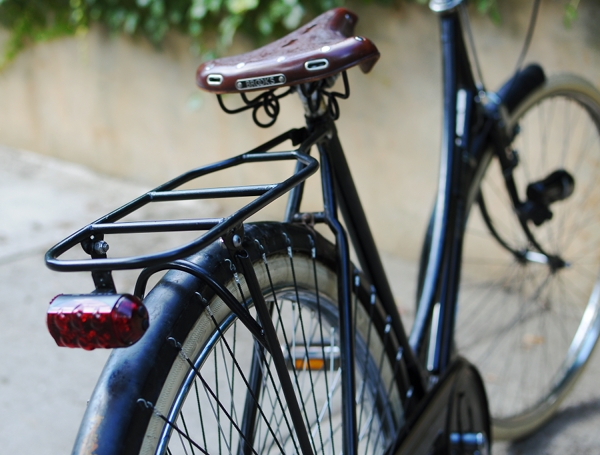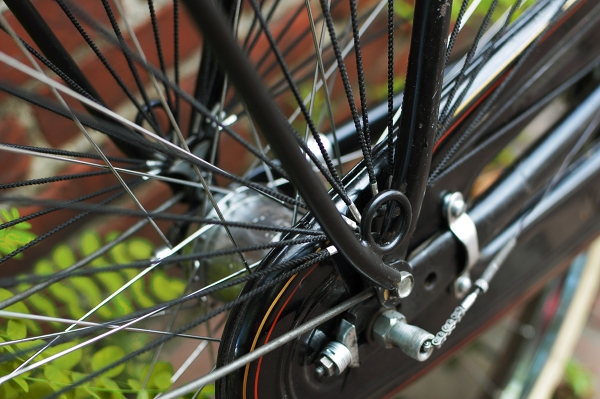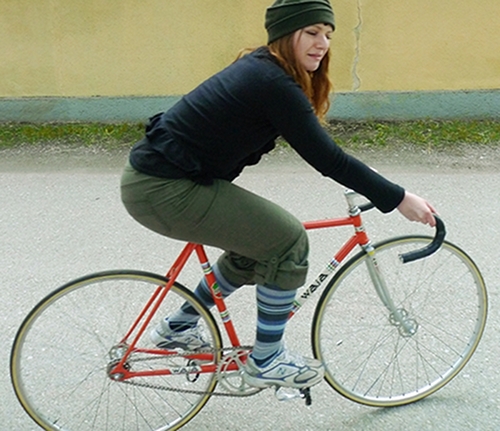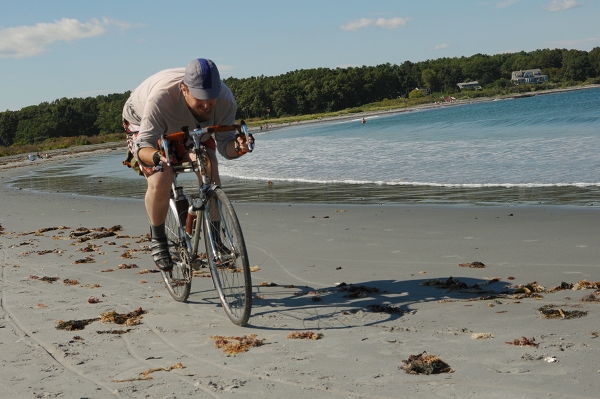Monday, January 31, 2011
Comments, Arguments, Bicycles...
Over the past couple of weeks, I've spent considerably more time moderaring comments than usual. For the most part, it's been a handful of readers getting overzealous in their debates with one another. But when hostility enters a discussion, others get sucked into it as well. All I know is: I don't want to be the Jerry Springer of bicycle blogs. I would rather have fewer comments, but retain the atmosphere of comradery that has been characteristic here thus far.
I have wondered whether discussions about bicycles are somehow more prone to conflict than other topics. Readers often tell me that they are uncomfortable commenting on various online bicycle forums and blogs, because they find the atmosphere hostile. And I understand that: I myself have a difficult time communicating on bikeforums, despite it being such a valuable resource for technical information. I also can no longer read the comments on Yehuda Moon, because of all the bickering between readers there. It is well documented that there exist genuine differences between what kind of interactions people find enjoyable: Some prefer for everything to be in the style of a debate, with technical inaccuracies in the wording of others victoriously exposed. Others favour a more nurturing, open form of communication. My own preference is somewhere in between: I like a good debate and I am fine with being challenged, as long as the underlying mood feels friendly.
Sometimes I think that we'd all be nicer over the internet, if we just imagined all the unknown others out there as kittens. Kittens, who love bicycles - at times feisty, but ultimately sweet and fluffy, pedaling happily through the fragrant meadows. Do you really want to hurt their feelings?
But for those who can't deal with the kitten metaphor and prefer specifics, I will be more direct: I think that it is a matter of common sense to refrain from mocking or deriding others' points of view in the comments. It's not that everyone has to agree, but sometimes there are nicer ways to disagree. In the same vein, consider refraining from statements that, while technically speaking may be phrased politely, you know in your heart of hearts are inflammatory (for example: "No offense meant, but riding a blue bicycle lowers your IQ and transmits STDs"). Finally, allow me to suggest that it is best to avoid making speculative, or misleading statements about individuals or entities that can be considered slanderous (for example: "I heard that Lovely Bicycle is written in the Far East, using child labor and toxic inks"). I trust that most people understand the difference between comments that are "in good faith" and "not in good faith."
Meaningful reader feedback has been a defining element of "Lovely Bicycle" from the start, and it makes me happy to be the hostess of such thoughtful, interesting discussions. As one reader recently suggested, my posts are collaborative: I offer my views, and others offer their views in return. It's a constructive exchange, which I think works nicely. Please help me keep it that way. And think of the cycling kittens.
Labels:
blog development,
social commentary
1910 Model 3 1/2 Norton
Sent by Andrew in Australia
This Norton is an original machine. It belonged to Eric Langton (brother of Oliver). It came out of South Australia about 40 years ago. It had corroded crankcases and Eric made a pattern and cast new ones but I have the original cases in my shed. I took these and lots more photos in the ally way behind the house where it is stored. I then took it home and fixed the magneto and rode it a few times. It went really well. I spent a far amount of time talking with Eric about pattern making and lots about riding for the Scott factory in the TT and then lots about world champianship speed way racing, all very interesting. I have just about finished a pattern for the cylinders for this machine if someone needs one.
This Norton is an original machine. It belonged to Eric Langton (brother of Oliver). It came out of South Australia about 40 years ago. It had corroded crankcases and Eric made a pattern and cast new ones but I have the original cases in my shed. I took these and lots more photos in the ally way behind the house where it is stored. I then took it home and fixed the magneto and rode it a few times. It went really well. I spent a far amount of time talking with Eric about pattern making and lots about riding for the Scott factory in the TT and then lots about world champianship speed way racing, all very interesting. I have just about finished a pattern for the cylinders for this machine if someone needs one.
Labels:
-Flat Tank models,
1910,
Model 03 1/2 HP
Sunday, January 30, 2011
Where Have You Been...
Since the end of the summer, I've received a number of concerned inquiries about "Velouria," my vintage Raleigh DL-1 Tourist (and for those who have only begun reading this blog recently, I am named after this bicycle, not the other way around). Though admittedly I have not featured her for some time, I assure you that Velouria is alive and well. She resides in our photo studio just South of Boston, performing the under-documented but crucial role of "studio bike." And here are the pictures to prove it.
For those unfamiliar with Velouria's history, she is somewhat of a "frankenbike," albeit a darling one. I acquired the 1973 Raleigh DL-1 in the summer of 2009 and over time proceeded to subject her to a number of modifications. These have included: an aftermarket chaincase and dress guards, cream tires, a Brooks B18 saddle, a custom rear rack, and an updated rear wheel with a coaster brake hub to supplement the pitiful braking power of the rod brakes.
Why do I feel the need to mess with a vintage bicycle in this manner? To tell the truth, part of it is simply the compulsion to experiment, to customise, to turn objects that belong to me into "creatures." I am not saying it's a good habit necessarily; but it's how I like to do things.
There was also a practical reason for all the modifications: I loved the ride quality of the DL-1 so much, that I was highly motivated to make it as functional as possible.
But ultimately, my love for this bicycle is also what made me move it to the photo studio after I (literally) found the vintage Gazelle in the end of last summer. At the risk of sounding cruel to the Gazelle, I am willing to run it into the ground. It is a great bike, it handles wonderfully, it is admirably designed, but my feeling toward is appreciation - not "love." The vintage Raleigh, on the other hand, feels almost like a pet. I just can't bring myself to ride its already battered and rusty frame on the salted roads in the winter, or even to leave it for hours in the rain in the summer. "Let the Gazelle take the abuse and spare the Raleigh," says my heart. And so Velouria became "studio bike" - ridden occasionally, but not too much.
And if you've noticed that these pictures are a little different from my typical bike photos, that is because they were taken inside the studio itself. We will soon be doing a couple of photo shoots for a local framebuilder, so we're practicing. When it comes to product photography in a studio setting, every object requires a different approach to lighting - and I would say that bicycles are fairly complicated as far as these things go. They are enormous, they have both matte and reflective parts, and they cast a variety of unusual shadows. Oh, and don't get me started on the kickstand thing; we are still working that one out!
Of course, the trouble with this type of product photography is that it brings every single detail of the object into sharp focus - not exactly the most flattering approach when it comes to vintage bikes!
But after all, "Velouria" is not just any vintage bike. She is mine. The scraped paint, the rust, the solidified crust, the dented fenders and even the bent rodbrake levers are, oddly, all part of what makes me cherish her. She may no longer be the most frequently featured bicycle here, but she epitomises the theme of this blog perhaps more than any other bike I own.
For those unfamiliar with Velouria's history, she is somewhat of a "frankenbike," albeit a darling one. I acquired the 1973 Raleigh DL-1 in the summer of 2009 and over time proceeded to subject her to a number of modifications. These have included: an aftermarket chaincase and dress guards, cream tires, a Brooks B18 saddle, a custom rear rack, and an updated rear wheel with a coaster brake hub to supplement the pitiful braking power of the rod brakes.
Why do I feel the need to mess with a vintage bicycle in this manner? To tell the truth, part of it is simply the compulsion to experiment, to customise, to turn objects that belong to me into "creatures." I am not saying it's a good habit necessarily; but it's how I like to do things.
There was also a practical reason for all the modifications: I loved the ride quality of the DL-1 so much, that I was highly motivated to make it as functional as possible.
But ultimately, my love for this bicycle is also what made me move it to the photo studio after I (literally) found the vintage Gazelle in the end of last summer. At the risk of sounding cruel to the Gazelle, I am willing to run it into the ground. It is a great bike, it handles wonderfully, it is admirably designed, but my feeling toward is appreciation - not "love." The vintage Raleigh, on the other hand, feels almost like a pet. I just can't bring myself to ride its already battered and rusty frame on the salted roads in the winter, or even to leave it for hours in the rain in the summer. "Let the Gazelle take the abuse and spare the Raleigh," says my heart. And so Velouria became "studio bike" - ridden occasionally, but not too much.
And if you've noticed that these pictures are a little different from my typical bike photos, that is because they were taken inside the studio itself. We will soon be doing a couple of photo shoots for a local framebuilder, so we're practicing. When it comes to product photography in a studio setting, every object requires a different approach to lighting - and I would say that bicycles are fairly complicated as far as these things go. They are enormous, they have both matte and reflective parts, and they cast a variety of unusual shadows. Oh, and don't get me started on the kickstand thing; we are still working that one out!
Of course, the trouble with this type of product photography is that it brings every single detail of the object into sharp focus - not exactly the most flattering approach when it comes to vintage bikes!
But after all, "Velouria" is not just any vintage bike. She is mine. The scraped paint, the rust, the solidified crust, the dented fenders and even the bent rodbrake levers are, oddly, all part of what makes me cherish her. She may no longer be the most frequently featured bicycle here, but she epitomises the theme of this blog perhaps more than any other bike I own.
Labels:
Raleigh,
restoration,
Velouria,
vintage
The Trading Post

Some basic guidelines, if you will:
Please describe the items you have/ want in list form. They are easier to read that way.
Remember to include your contact info!
You do not need to post an equal number of "have" and "want" items. It's fine to post only one and not the other.
Monetary exchanges are fine, but please do not list selling prices here. If you are interested in an item and would like to buy it instead of trading for it, please contact the lister privately over email.
Not everything in your list needs to be bicycle-specific. For example: your "want" list can include bicycle components, but your "have" list can include vintage cameras.
Please do not reply to each other in the comments, but contact the lister directly if you have any questions for them. I will occasionally go through the comments to clean up clutter.
Post as often as you like, and feel free to delete your older comments if they contain outdated information.
I am not responsible for the comments posted by other readers, for any items offered by other readers, or for your interactions with other readers. Please use your judgment!
Saturday, January 29, 2011
1929 Model 18 Norton
Sent by Roger
This 1929 Model 18 is owned by one of the volunteers at Brooklands and he has brought it to the museum so that its restoration can finally be completed. I am not sure of its history except that it was owned by the present owner's father for at least 50 years.
This 1929 Model 18 is owned by one of the volunteers at Brooklands and he has brought it to the museum so that its restoration can finally be completed. I am not sure of its history except that it was owned by the present owner's father for at least 50 years.
Barter Economy
Some of my most interesting bicycle-related acquisitions have been through trades with others, and I find these barter exchanges to be great. Whether bicycle related or not, trades can work out nicely - with each party feeling as if they are getting something new and useful.
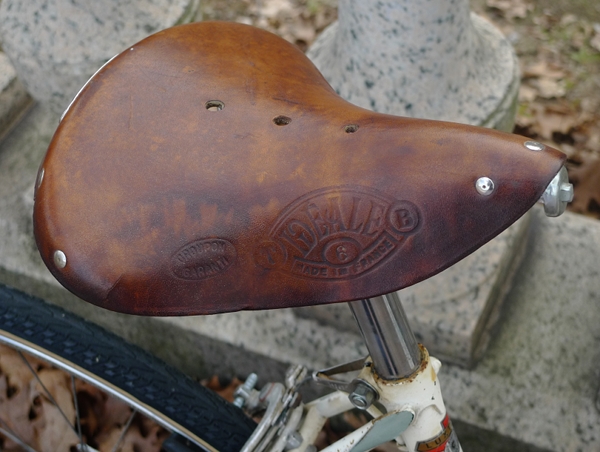 For instance, I received this vintage Ideale saddle in exchange for some vintage Brooks.
For instance, I received this vintage Ideale saddle in exchange for some vintage Brooks.
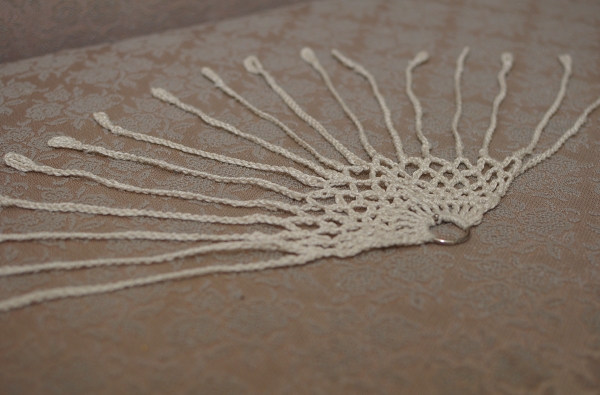 I received these beautiful dressguards in exchange for a spare saddlebag.
I received these beautiful dressguards in exchange for a spare saddlebag.
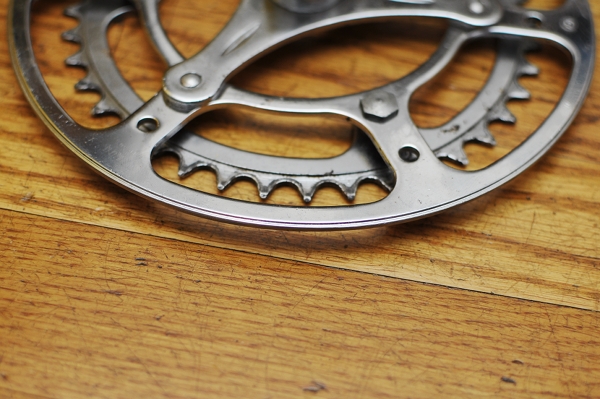 I even had some custom metalwork done in exchange for a basket. Other trades have included embroidery in exchange for a rear rack, collectible fountain pens in exchange for artwork, and products in exchange for photography.
I even had some custom metalwork done in exchange for a basket. Other trades have included embroidery in exchange for a rear rack, collectible fountain pens in exchange for artwork, and products in exchange for photography.
A good place to start looking for bartering opportunities as far as bicycles go, is bikeforums. They've set up "For Trade" threads for different geographical regions, where you can list the items you have available and the items you are looking for. Here is the one for the Northeastern USA. I have been considering setting up something similar - but cannot think of a way to do it without it eating up too much of my time.
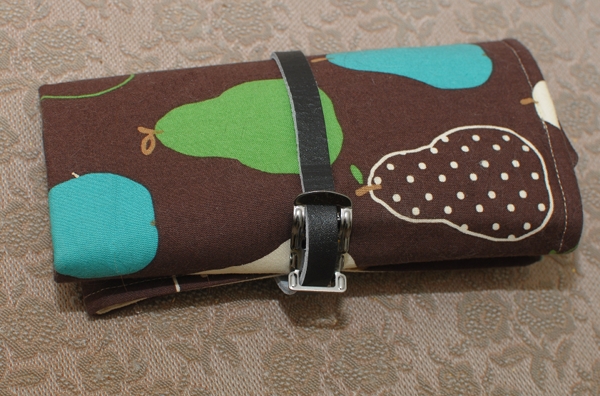 And while trades can be pre-determined and formal ("I'll give you my Item X in exchange for your Item Y"), they can also be a sort of reciprocal, whimsical gift-giving - like pen pals exchanging objects instead of letters: You send the person something you think they might like, and at some later point they do the same. There are no explicit arrangements or expectations, and that is the neat thing about it. I've had these types of exchanges with several bike people, and it's been really nice - my latest gift being the delightfully named "bike burrito."
And while trades can be pre-determined and formal ("I'll give you my Item X in exchange for your Item Y"), they can also be a sort of reciprocal, whimsical gift-giving - like pen pals exchanging objects instead of letters: You send the person something you think they might like, and at some later point they do the same. There are no explicit arrangements or expectations, and that is the neat thing about it. I've had these types of exchanges with several bike people, and it's been really nice - my latest gift being the delightfully named "bike burrito."
 These things have fascinated me for some time, so I was pretty happy to get one. It's called a "bike burrito" because - well, it folds up like a burrito.
These things have fascinated me for some time, so I was pretty happy to get one. It's called a "bike burrito" because - well, it folds up like a burrito.
...And unfolds to reveal compartments for your tools. (We all have different concepts of "tools!")
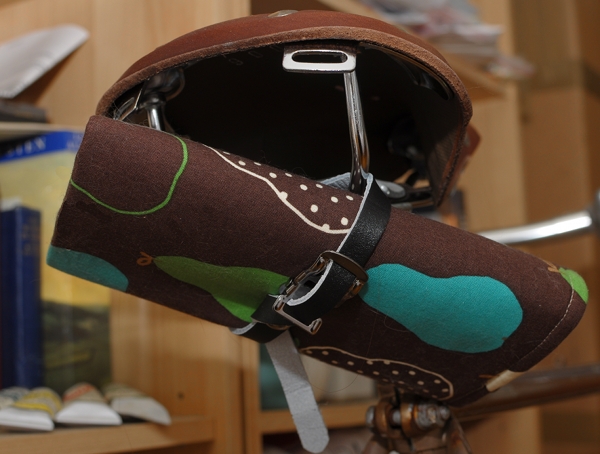 The "burrito" is held together by a toe-clip strap, which can be easily threaded through the rails under your saddle. With the "epic" winter we are having, it's safe to say that I won't be using it any time soon - but it deserves to be seen!
The "burrito" is held together by a toe-clip strap, which can be easily threaded through the rails under your saddle. With the "epic" winter we are having, it's safe to say that I won't be using it any time soon - but it deserves to be seen!
Connecting with other bicycle-loving people from around the world can be fun, and can lead to all sorts of exchanges you would not otherwise have. What are your thoughts on developing a system to facilitate this? Would you find it helpful? What features would be useful? Would simply using the comments section of a post be enough, or do you think it won't work without a message board? Ideas welcome!



A good place to start looking for bartering opportunities as far as bicycles go, is bikeforums. They've set up "For Trade" threads for different geographical regions, where you can list the items you have available and the items you are looking for. Here is the one for the Northeastern USA. I have been considering setting up something similar - but cannot think of a way to do it without it eating up too much of my time.


...And unfolds to reveal compartments for your tools. (We all have different concepts of "tools!")

Connecting with other bicycle-loving people from around the world can be fun, and can lead to all sorts of exchanges you would not otherwise have. What are your thoughts on developing a system to facilitate this? Would you find it helpful? What features would be useful? Would simply using the comments section of a post be enough, or do you think it won't work without a message board? Ideas welcome!
Labels:
bags,
basket,
dress guards,
saddles
Thursday, January 27, 2011
Stop, Look Around...
All the walking I've been doing lately on account of the weather has made me pay even closer attention to my surroundings than I do while cycling. Everything looks different in the snow - elegant and magical. The thin patch of woods near my house has turned into a majestic white forest worthy of a 19th century Scandinavian painting. It's as if the sky was squeezed straight out of a tube of cerulean blue and the austere vertical strokes of the trees were applied with a pallet knife. It's not my style, but I am certain this scene has been painted many times. It's archetypal.
Upon emerging from the pristine wonderland, I came face to face with this. Literally: It was located at face level, and in my willingness to submerge myself so fully in my daydream, I nearly walked into it.
The city is using excavators to facilitate snow removal, as the plows alone are not enough. The effect is interesting, making the neighbourhood look like an igloo construction zone. In order to clear the center of the roads, the excavator dumps more and more snow to the sides - creating monstrous, densely packed snowbanks that line the streets like the walls of some arctic city-state.
Walking on the sidewalk is a surreal experience. You are essentially in a tunnel - with buildings on one side, igloo wall on the other. Along some stretches, the snowbanks are taller than the average human height, so as a pedestrian I can only see the sidewalk in front of me and not the road to the side of me.
Those "Do Not Enter" and "Except Bicycles" signs are for a one-way side street that has a bike lane going in the direction against traffic. For most of last winter the lane looked like this. How cute that I complained about it then: This year it's been swallowed up by the snow banks entirely.
It is not uncommon to encounter bicycles "buried alive." There were actually three separate bicycles inside this snowbank.
Less common is the sight of a bicycle being ridden - but it happens, especially on the heavily salted main roads. Note how the yellow crosswalk sign, its reflection in the puddle, and the golden light of the setting sun play off the colours in the cyclist's knitted hat - all of it especially noticeable against the white, snowy backdrop. Somehow, everything seems to be reminding me of a painting these days. Certainly this person and his hat deserve to be painted.
It's been over a month and a half now without the car. We signed up for zipcar through the Co-Habitant's work, but have not used it yet. And ironically, the blizzards are making it easier to do without: With the roads as bad as they are, we wouldn't have been traveling to any photoshoots up North anyway, and so we don't feel as if not having our car is keeping us from accomplishing anything. We'll get the car fixed as it gets closer to Spring. But for now, it's been remarkably easy to just forget about that thing and for us both to get around entirely on foot and bike. And with so many snow days, I am rediscovering walking - which I appreciate for making me stop, look around, and see my neighborhood in a new light.
Upon emerging from the pristine wonderland, I came face to face with this. Literally: It was located at face level, and in my willingness to submerge myself so fully in my daydream, I nearly walked into it.
The city is using excavators to facilitate snow removal, as the plows alone are not enough. The effect is interesting, making the neighbourhood look like an igloo construction zone. In order to clear the center of the roads, the excavator dumps more and more snow to the sides - creating monstrous, densely packed snowbanks that line the streets like the walls of some arctic city-state.
Walking on the sidewalk is a surreal experience. You are essentially in a tunnel - with buildings on one side, igloo wall on the other. Along some stretches, the snowbanks are taller than the average human height, so as a pedestrian I can only see the sidewalk in front of me and not the road to the side of me.
Those "Do Not Enter" and "Except Bicycles" signs are for a one-way side street that has a bike lane going in the direction against traffic. For most of last winter the lane looked like this. How cute that I complained about it then: This year it's been swallowed up by the snow banks entirely.
It is not uncommon to encounter bicycles "buried alive." There were actually three separate bicycles inside this snowbank.
Less common is the sight of a bicycle being ridden - but it happens, especially on the heavily salted main roads. Note how the yellow crosswalk sign, its reflection in the puddle, and the golden light of the setting sun play off the colours in the cyclist's knitted hat - all of it especially noticeable against the white, snowy backdrop. Somehow, everything seems to be reminding me of a painting these days. Certainly this person and his hat deserve to be painted.
It's been over a month and a half now without the car. We signed up for zipcar through the Co-Habitant's work, but have not used it yet. And ironically, the blizzards are making it easier to do without: With the roads as bad as they are, we wouldn't have been traveling to any photoshoots up North anyway, and so we don't feel as if not having our car is keeping us from accomplishing anything. We'll get the car fixed as it gets closer to Spring. But for now, it's been remarkably easy to just forget about that thing and for us both to get around entirely on foot and bike. And with so many snow days, I am rediscovering walking - which I appreciate for making me stop, look around, and see my neighborhood in a new light.
Labels:
cars,
Gazelle,
winter cycling
Wednesday, January 26, 2011
Racking Your Brain!
For the past month, I have been working on a rear rack prototype for the Bella Ciao "Superba" (which will look nothing like the Roadster rack above), so racks have been on my mind lately. I've been checking out the racks on practically every bike I see, and also paying attention to how I typically use mine.
Although on occasion I will carry a substantial amount of weight on the rear rack of my bike, more often than not all I carry is a single pannier or bag. Sometimes there are groceries and packages involved, and even those often fit into a single large pannier. Once in a while, I will strap an item or two to the top of the rack, but it is not an everyday occurrence. When I look around at other cyclists, at least in the Boston area, I see mostly the same: One or two panniers attached to the side of the rack, or a bag strapped to the top. If I see more than that being transported (on a regular bike, not an Extracycle or a "utility bike"), it's an anomaly.
What about you? Be honest - how much do you really carry on your bicycle's rear rack on a typical day, assuming that it is a standard city bike?
Looking at other cyclists in the Boston area, I've also noticed a gender difference in how much stuff cyclists carry - with women typically having fewer things strapped to the rear rack than men. But there could be many factors accounting for this, and I am not sure how typical this trend is overall.
In addition to how much stuff I carry on the rear racks of my bicycles, I have also been trying to note in what ways I find them convenient versus not. For example, I often lament the lack of bungee cord attachment points on my Gazelle's rear rack. Also, not all racks are compatible with all pannier attachment system - the spacing of the slats on some racks can interfere with the spacing of the hooks. What major complaints, if any, do you have about the rear rack on your main transportation bicycle? You can select multiple items on this one:
Having discovered how to embed these polls and surveys, I admit it's fun to set them up and then look at all the results - but hopefully also useful. I will soon be receiving a sample of the "Superba" rack prototype, and from there it should be just a matter of time until we're done. These racks will fit a standard 700C wheel bike, and regardless of whether you are interested in a "Superba" bicycle, the racks may be available for sale on their own. They won't be sold by me, but I will keep you posted - and your input will certainly be valuable.
Although on occasion I will carry a substantial amount of weight on the rear rack of my bike, more often than not all I carry is a single pannier or bag. Sometimes there are groceries and packages involved, and even those often fit into a single large pannier. Once in a while, I will strap an item or two to the top of the rack, but it is not an everyday occurrence. When I look around at other cyclists, at least in the Boston area, I see mostly the same: One or two panniers attached to the side of the rack, or a bag strapped to the top. If I see more than that being transported (on a regular bike, not an Extracycle or a "utility bike"), it's an anomaly.
What about you? Be honest - how much do you really carry on your bicycle's rear rack on a typical day, assuming that it is a standard city bike?
Looking at other cyclists in the Boston area, I've also noticed a gender difference in how much stuff cyclists carry - with women typically having fewer things strapped to the rear rack than men. But there could be many factors accounting for this, and I am not sure how typical this trend is overall.
In addition to how much stuff I carry on the rear racks of my bicycles, I have also been trying to note in what ways I find them convenient versus not. For example, I often lament the lack of bungee cord attachment points on my Gazelle's rear rack. Also, not all racks are compatible with all pannier attachment system - the spacing of the slats on some racks can interfere with the spacing of the hooks. What major complaints, if any, do you have about the rear rack on your main transportation bicycle? You can select multiple items on this one:
Having discovered how to embed these polls and surveys, I admit it's fun to set them up and then look at all the results - but hopefully also useful. I will soon be receiving a sample of the "Superba" rack prototype, and from there it should be just a matter of time until we're done. These racks will fit a standard 700C wheel bike, and regardless of whether you are interested in a "Superba" bicycle, the racks may be available for sale on their own. They won't be sold by me, but I will keep you posted - and your input will certainly be valuable.
Tucker wins the 1929 200 mile sidecar race
By Roger
I have found the attached picture of Tucker immediately after the win in the 1929 200 mile race - the numbers are the same. The engine is clearly an ES2 but the frame is earlier and the forks are certainly side spring braced Druids. A noticeable change is the loss of the tank lining or perhaps a new tank was put on for the publicity pictures!
Like other Brooklands riders of the period, George Tucker would have kept using his machines until they were no longer serviceable. The mid to late 1920s were a period of severe shortages with a general strike in 1926 and the depression beginning to bite in 1929 - Pat was still using his 1925 TT machine in 1929 and possibly later. Tucker's frame is likely to have been made around 1927 and the forks could even be the 1925 TT ones - the 1925 machines used the four speed cross over gearbox so it is not that one. The rear brakes remained the V-block type until the end of the flat tankers at Brooklands presumably because they were lighter.
The frame would be a Model 19 to take the taller engine which also has the ES2 head with the angled exhaust port. I suspect that Norton supplied the engine - or parts - for racing as Simon has told me that the Model 19 crank won't fit the ES2 cases and I don't think that Norton sold a bigger ES2. Tucker probably would not have had the resources to make his crankshaft and that this would therefore have been done by the works as he was a tuner rather than an engineer much like Driscoll who had others do the engineering. George was a Norton main dealer in Bristol so he would have access to factory components even if he was not officially supported by the works by that time. He did win a Grand Pix with Walter Moore in the chair in 1923/4.
The race report says that all three Nortons were 588cc which is what I would expect. Tucker didn't use long (8 1/2") conrods in his 490cc engines (JdK: which makes the 490cc engines appear as 588cc models) as these were only used by the Spring/Driscoll team from what I have seen. O'Donovan did try a long rod around 1926 but he used an 8" rod from the 588 as did Pat around the same time.
Simon: "There were a few 588 ES2 engines made/sold by Nortons. It is only the differing main shaft diameters which means that standard 588 flywheels can't be used in ES2s."
I have found the attached picture of Tucker immediately after the win in the 1929 200 mile race - the numbers are the same. The engine is clearly an ES2 but the frame is earlier and the forks are certainly side spring braced Druids. A noticeable change is the loss of the tank lining or perhaps a new tank was put on for the publicity pictures!
Like other Brooklands riders of the period, George Tucker would have kept using his machines until they were no longer serviceable. The mid to late 1920s were a period of severe shortages with a general strike in 1926 and the depression beginning to bite in 1929 - Pat was still using his 1925 TT machine in 1929 and possibly later. Tucker's frame is likely to have been made around 1927 and the forks could even be the 1925 TT ones - the 1925 machines used the four speed cross over gearbox so it is not that one. The rear brakes remained the V-block type until the end of the flat tankers at Brooklands presumably because they were lighter.
The frame would be a Model 19 to take the taller engine which also has the ES2 head with the angled exhaust port. I suspect that Norton supplied the engine - or parts - for racing as Simon has told me that the Model 19 crank won't fit the ES2 cases and I don't think that Norton sold a bigger ES2. Tucker probably would not have had the resources to make his crankshaft and that this would therefore have been done by the works as he was a tuner rather than an engineer much like Driscoll who had others do the engineering. George was a Norton main dealer in Bristol so he would have access to factory components even if he was not officially supported by the works by that time. He did win a Grand Pix with Walter Moore in the chair in 1923/4.
The race report says that all three Nortons were 588cc which is what I would expect. Tucker didn't use long (8 1/2") conrods in his 490cc engines (JdK: which makes the 490cc engines appear as 588cc models) as these were only used by the Spring/Driscoll team from what I have seen. O'Donovan did try a long rod around 1926 but he used an 8" rod from the 588 as did Pat around the same time.
Simon: "There were a few 588 ES2 engines made/sold by Nortons. It is only the differing main shaft diameters which means that standard 588 flywheels can't be used in ES2s."
Who's Afraid of Toe Overlap?
The idea of "toe overlap" or "toe clip overlap" (TCO) is one of those hot button topics that can cause metaphorical bloodshed in online discussions among bicycle enthusiasts. Still, I would like to have a go at it, as I think my perspective reflects the type of cyclist who does not typically take part in these debates. I would also like to discuss the topic from both sides of the argument, encouraging readers to form their own opinions. In short, here are my 2 cents:
What is toe overlap?
On some bicycles, it is possible to hit the front wheel with your toe when turning at slow speeds. This interference (or overlap) between your toe and the wheel can make you fall. Toe overlap is especially common on bicycles with small frame sizes and large wheels. If you picture what happens to the wheels of a bike as the frame gets smaller (as the top tube gets shorter, the wheels move closer together), it makes sense why that is so.
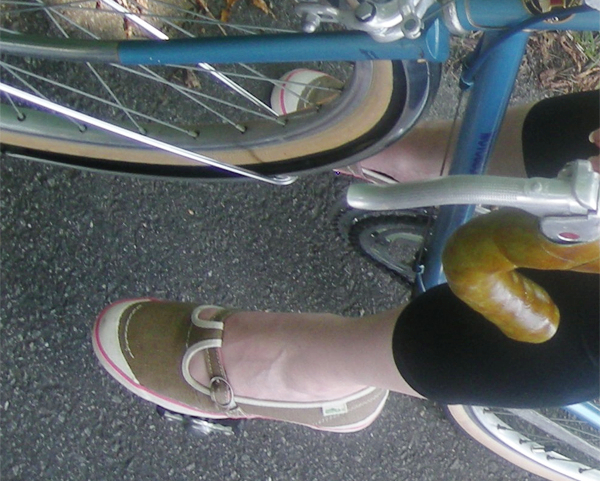
I don't think there is an answer to this question that rings true for everyone, but I will try to cover multiple sides of the argument.
An argument for "no": Chances are that you already have a bike with toe overlap and simply haven't noticed. Try it: make a slow, sharp U-turn on a quiet street or in a parking lot, and pay attention to whether your toe can potentially hit the wheel as you are making the turn. The overlap is more drastic on some bikes than on others, but most smaller-frame production bicycles have it to some degree. The reason many cyclists remain blissfully unaware of it, is that we rarely cycle at speeds slow enough for the wheel to turn so sharply as to cause the overlap. So while the overlap is a theoretical possibility, it is not usually a threat.
An argument for "yes": Cyclists do occasionally make turns slow enough to cause toe overlap. Instances when that might happen include the aforementioned U-turns, as well as slow turns in urban traffic. In addition, beginner cyclists tend to go slower than experienced cyclists - making them more vulnerable to toe overlap.
An argument for "no": Some in the bicycle industry will argue that toe overlap is not so much a "problem" as a reality, and it is the cyclist's responsibility to learn to deal with it. Even on bikes with dramatic toe overlap, and even when those bikes are fixed gear (i.e. coasting through a turn is not an option), there is a way to time your pedal strokes so that your toe does not hit the turned wheel. There are formulas and instructions for this. Over time, it becomes "second nature."
An argument for "yes": What is "second nature" to some, may not be to others, even over time. There are some experienced cyclists who've had bad falls as a result of toe overlap. The bottom line is, that if your bike has toe overlap, and if you actually manage to hit the front wheel with your toe as a result (or get your toe jammed in there, which also happens), you could have a bad fall while trying to execute a turn. Therefore, at least in theory, a bike with toe overlap is more accident prone, than a bike without. Some would argue that this in itself makes it a "problem" and not just a "feature" of the bike.
What can be done to avoid toe overlap on small size bikes?
In theory, a few things can be done by the framebuilder or manufacturer to create small size frames without toe overlap. The problem is, that all of these changes have consequences that can be perceived as drawbacks. For example:
Smaller wheel size: Toe overlap can usually be eliminated on a small frame by fitting the bike with proportionally smaller wheels. For instance: 650B instead of the typical 700C on a roadbike, or 26" instead of the typical 28" on a roadster-type bicycle. The reason this is seldom done on production bikes, is that it is more costly for a manufacturer to design different sized frames around different wheels. Additionally, cyclists themselves tend to have an aversion to smaller wheels, due to a commonly held belief that larger wheels are faster. This makes smaller wheeled bikes less popular, despite their no-TCO advantage.
Changes in frame geometry: Toe overlap can also be eliminated by a number of changes to frame geometry. The simplest method is to make the the top tube a bit longer and the seat tube a bit steeper, which will create more space between the front wheel and the crankset without changing the way a bicycle handles too much. However, a longer top tube means that you will either be too stretched out on the bike, or will need a super-short stem. And a steep seat tube means that you may either be uncomfortable with the aggressive angle, or will need to find a seat post with considerable set-back. If you prefer a relaxed seat tube angle and a reasonable top tube length, then the other options are more complicated, as they involve messing with the bicycle's handling: Making the head tube slacker and increasing the fork rake will reduce toe overlap as well, but it could make the bicycle less responsive, which many cyclists would find undesirable. I don't want to turn this into a lesson in frame geometry, but suffice to say that some would prefer to deal with the toe overlap, rather than make either of these changes to their bike.
Conclusions?
It is hard to find a definitive answer to the questions of whether toe overlap is a problem, and of how to eliminate it. Different frame builders, bicycle fitters, and other industry spokespersons will tell you different things, and they may all sound perfectly convincing and reasonable while you are listening to them... until you hear the other guy's argument for the opposite, and it will sound equally convincing and reasonable.
My personal view is that toe overlap is a problem if you consider it a problem. And if you do, then I don't think it's right for anybody in the bicycle industry to try and persuade you otherwise in order to sell you a bike. Ultimately, it should be up to the cyclist to decide and for the framebuilder, or salesperson, to accommodate.
Labels:
comfort,
frame building
Subscribe to:
Posts (Atom)
Blog Archive
-
▼
2011
(631)
-
▼
January
(213)
- Comments, Arguments, Bicycles...
- 1910 Model 3 1/2 Norton
- Where Have You Been...
- The Trading Post
- 1929 Model 18 Norton
- Barter Economy
- Stop, Look Around...
- Racking Your Brain!
- Tucker wins the 1929 200 mile sidecar race
- Who's Afraid of Toe Overlap?
- Regular Wool vs 'Technical' Wool
- Getting a Custom Bicycle, Part II: Choosing a Fram...
- Motors To The Rest of World War II
- Chavez also lambasted Toyota
- A Government Soldier Killed
- A worker Waits As Goods
- Hugo Chavez Greets Supporters
- Hugo Chávez Rides The Atomic Bicycle
- Motor Suzuki Skydrive Dynamatic 125 cc reviews
- Bajaj Pulsar 135 LS (Light Sport) SOHC DTS-i Reviews
- Bajaj Pulsar Fairing Motorcycles Pics
- yamaha motorcycle R1 magnificent
- girl and yamaha motorcyle R1
- Superba Colour and Other Decisions: Your Feedback ...
- Andrew's 1910 Big Four Norton
- The Least Daunting Option
- Lugwork Preferences
- CS1 flat tank Norton
- What Do Bike Shops Want to Sell You, and Why?
- Bicycle Portraits in Ambrotype and Tintype
- Gas Moped Scooter
- Showing Off or Showing How? On Bicycle Blog Exhibi...
- Lean and mean: the Icare motorcycle concept will t...
- A Lovely Touring Bike... For You?
- 1925 Model 18 Norton
- Brooks Colt: New vs Vintage
- Two Wheeled Tweets
- Sturmey Archer positive stop mechanisms
- tron motorcycle
- The Case of the Disappearing Bike Lanes
- On Bicycle Maintenance and Limitations
- Peter's Model 19 Norton
- A Functional Blizzard
- Domesticating the Transportation Bicycle?
- 1929 Model 18 Norton
- The Anthology Of Motorcycle
- Older Issue Of Motor Cycling
- Motorcycle Pin-Up Girl Giclee
- Kaiser Bill's Car
- King George III
- Riding Car - The First Petroleum Powered Vehicle
- Motorcycles For Military and Police
- Liberty Cadillac - 1918
- 1970 Opel GT
- Rolls-Royce Silver
- Buick Limited
- A Porsche Speedster
- Pre-War Antique Car
- 1948 Ford Super Deluxe
- Rare 1970 Dodge Challenger R/T SE in Panther Pink
- 1912 McIntyre
- 1934 Graham convertible
- Dream Car Garage
- 1959 Austin-Healey Sprite
- When President Kennedy Was Shot
- The Classic Greek Tragedy
- Mass Panic at German Music Festival
- US can't seal Afghan-Pakistan border
- A Fun Thing For Both Boys
- Evacuation of injured South Vietnamese
- Keeping His Little Sister
- Extricate Wounded Civilians
- The Bella Ciao 'Superba' - My Take on the Italian ...
- The Mary Poppins Effect?
- 1927 Model 18 Norton
- Bicycle Trainers and Winter Withdrawal
- Fotos de el Che Guevara
- On the road to revolution - the ‘back story’ to Er...
- The Award of Posthumous Membership of the NACC to ...
- British Bikers Following Che Guevara’s Tracks
- The children of former president Ferdinand Marcos
- Ferdinand Marcos’ Restless Corpse
- John F. Kennedy's Lincoln Presidential Limousine
- Argentine president Nestor Kirchner In The Car
- President Ferdinand Marcos and his wife Imelda
- Administrative assistant in Cal State San Marcos P...
- Armored 1988 Mercedes-Benz 500 SEL - car president...
- The Iron Man - Sardar Patel
- Architect of Modern India - Jawaharlal Nehru
- Jawaharlal Nehru In The Car
- Former Wife of Sukarno with New Husband
- Dewi Sukarno and Her Daughter
- Dewi Sukarno Admiring Her Infant
- Madame Sukarno Having Hair Done
- Sukarno at Disneyland
- President Kenendy and Indonesian President Sukarno...
- President Kennedy Greets President Sukarno
- Achmed Sukarno Waving from His Limousine
- John Kennedy Inspecting Soldiers
- President Kennedy and Indonesia's President Sukarn...
-
▼
January
(213)















